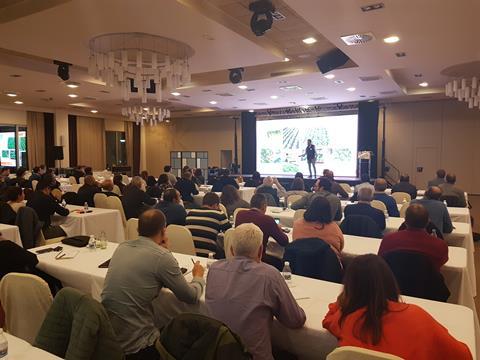
Nunhems® has once again decided to go against the tide with the clear aim of revolutionising the Romaine lettuce market. Having analysed the main market trends, BASF's horticultural seed brand has made a firm commitment to a smaller type of Romaina lettuce as the basis for a new strategy that pursues three main objectives: encourage consumption, reduce production costs and more efficient use of the soil and resources needed to grow crops, while reducing food waste.
With a smaller size, the new Nunhems® Romaine lettuce varieties are ideal for highdensity growing systems. Pieces of less than 500 grams can be increased from 50,000 to 92,000 lettuces per hectare and production costs can be significantly reduced. 'With the prices before shipping that lettuce has registered over the last ten years, a hectare of Romaine needs at least 70,000 pieces to be profitable', according to Alfonso Fernández, Sales Specialist Salads of BASF Vegetable Seeds.
An intense, sweet taste is the other quality that defines the new generation of Nunhems® Romaine lettuce. Market research confirms that 56% of European consumers associate quality with taste. For this reason, Romaine lettuce organoleptic qualities and consumption experience are a priority for Nunhems®, which also offers important shape and colour novelties, to achieve product differentiation at the point of sale and consumer loyalty.
The new Romaine lettuce varieties also focus on facilitating production throughout the year, as they can be grown in different areas of Europe to complete production calendar. The same varieties can be produced during autumn and winter in Spain and during the spring-summer cycle in northern Europe, always with a top taste and a very attractive size for the entire continental market.
The details of this new sales strategy to turn Romaine lettuce into a Premium vegetable were announced in La Palma (Cartagena) during the 'Romaine Revolution' event, where the Nunhems® brand shared with the main representatives of the industry, the important advantages that the new Romaine varieties incorporate. 'We have worked very hard to differentiate Romaine lettuce for its colour, shape and flavour because from now on we want it to be perceived as a healthy and Premium food', explained Alfonso Fernández, Sales Specialist Salads of BASF Vegetable Seeds during his speech.
'The market for Romaine lettuce is declining in Spain but is growing steadily in the United Kingdom and Northern Europe. Therefore, market data confirms that there is a business opportunity to start doing things differently and, thanks to innovation, turn Romaine lettuce into a food capable of satisfying the current needs of the European consumer', explained Sara Rodriguez, Client Director of Kantar Worldpanel Spain during her intervention yesterday at 'Romaine Revolution'.
During the event, which was a success in terms of attendance, Nunhems® offered the main agents of the industry a complete report on the advantages of Big Data to improve decision making in any of the links of the food chain. 'Big Data already makes the difference between being competitive or not in a global market and its incorporation into business strategies has a great positive impact on the profitability of companies,' said Gonzalo Martin, Director of Hispatec Analytics.



No comments yet